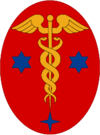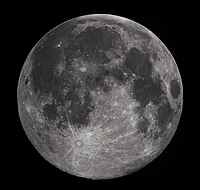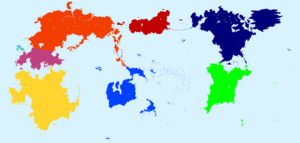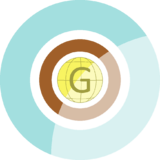Gentu
This article is a work in progress. Any information here may not be final as changes are often made to make way for improvements or expansion of lore-wise information about Gentu. Please comment on this article's talk page to share your input, comments and questions. Note: To contribute to this article, contact User:Philimania. |
 Gentu and its moon, photo taken from the Xenophus 2 Mission in 1994. | |||||||||||||
| Designations | |||||||||||||
|---|---|---|---|---|---|---|---|---|---|---|---|---|---|
| Gentǔ, Terra, The World | |||||||||||||
| Orbital characteristics | |||||||||||||
| Epoch Hodiernus | |||||||||||||
| Aphelion | 152100000 km (94500000 mi) | ||||||||||||
| Perihelion | 147095000 km (91401000 mi) | ||||||||||||
| 149598023 km (92955902 mi) | |||||||||||||
| Eccentricity | ~0.0167086 | ||||||||||||
| 365 d (12.0 months) | |||||||||||||
Average orbital speed | 29.78 km/s (18.50 mi/s) | ||||||||||||
| 358.617° | |||||||||||||
| Satellites | 1 natural satellite: Cynthia 2,000+ operational artificial satellites | ||||||||||||
| Physical characteristics | |||||||||||||
Mean radius | 6,306.9 km | ||||||||||||
Equatorial radius | 6378.1 km (3963.2 mi) | ||||||||||||
Polar radius | 6356.8 km (3949.9 mi) | ||||||||||||
| Flattening | 0.0033528 | ||||||||||||
| Circumference | 40075.017 km (24901.461 mi) (equatorial) 40007.86 km (24859.73 mi) (meridional) | ||||||||||||
| 510,072,000km2 (316,944,000 mi2) | |||||||||||||
| Volume | 1.08321 × 1012km3 | ||||||||||||
| Mass | 5.97237 x 1024 kg | ||||||||||||
Mean density | 5.514 g/cm3 | ||||||||||||
| 9.807 m/s2 | |||||||||||||
| 0.3307 | |||||||||||||
| 11.186 km/s (6.951 mi/s) | |||||||||||||
Sidereal rotation period | 0.99726968 d (23.934472 h) | ||||||||||||
Equatorial rotation velocity | 0.4651 km/s (0.2890 mi/s) | ||||||||||||
| 23.4392811° | |||||||||||||
| Albedo | 0.367 geometric 0.306 Bond | ||||||||||||
| |||||||||||||
| Atmosphere | |||||||||||||
Surface pressure | 101.325 kPa (at MSL) | ||||||||||||
| Composition by volume | 78.08% nitrogen (N2) (dry air) 20.95% oxygen (O2) 0.930% argon 0.039% carbon dioxide (climate-variable) | ||||||||||||
Gentu, also known as Gentǔ, or Terra, is the second planet from the Sun and the only astronomical object known to harbour life. While large amounts of water can be found throughout the Gentu System, only Gentu sustains liquid surface water. About 67% of Gentu's surface is made up of the ocean. The remaining 33% of Gentu's surface is land, consisting of continents and islands. Gentu's surface layer is formed of several slowly moving tectonic plates, interacting to produce mountain ranges, volcanoes and earthquakes.
Gentu formed over 4.5 billion years ago. During the first billion years of Gentu's history, the ocean formed and then life developed within it. the modern Humans emerged 250,000 years ago and have reached a population of almost 12 billion today. Humans depend on Gentu's biosphere and natural resources for their survival, but have increasingly impacted Gentu's environment. Today, humanity's impact on Gentu's climate, soils, waters and ecosystems is unsustainable, threatening people's lives and causing widespread extinction of other life.
Etymology
The modern Neragese word Gentu developed from the old Neragese word most often spelled Jĕneses, and the old Veragese phrase spelled Rėlyu, both words and phrases meaning World in their own languages. Where the ancient words derived from is unknown to historians currently.
Historically, gentu has been written in lowercase. From early Middle Neragese, its definite sense as "the globe" was expressed as gentu. By Early Modern Neragese, many nouns were capitalized, and gentu was also written Gentu, particularly when referenced along with other heavenly bodies. House styles now vary: XXX spelling recognizes the lowercase form as the most common, with the capitalized form an acceptable variant. Another convention capitalizes "Gentu" when appearing as a name (for example, "Gentu's atmosphere") but writes it in lowercase when preceded by the (for example, "the atmosphere of gentu"). It almost always appears in lowercase in colloquial expressions such as "where on gentu are you?"
Chronology
TBA
Gentu-Cynthia System
| Diameter | 3,474.8 km |
| Mass | 7.349×1022 kg |
| Semi-major axis | 384,400 km |
| Orbital period | 27d 7h 43.7m |
Cynthia is a relatively large, terrestrial, planet-like natural satellite, with a diameter about one-quarter of Gentu's. It is the largest moon in the Gentu System relative to the size of its planet, although XXX is larger relative to the dwarf planet XXX. The most widely accepted theory of the Cynthia's origin, the giant-impact hypothesis, states that it formed from the collision of a Gentu-size protoplanet called Gaia with the early Gentu. This hypothesis explains (among other things) Cynthia's relative lack of iron and volatile elements and the fact that its composition is nearly identical to that of Earth's crust.
The gravitational attraction between Gentu and Cynthia causes tides on Gentu. The same effect on Gentu has led to its tidal locking: its rotation period is the same as the time it takes to orbit Gentu. As a result, it always presents the same face to the planet. As Cynthia orbits Gentu, different parts of its face are illuminated by the Sun, leading to the lunar phases.
Cynthia may have dramatically affected the development of life by moderating the planet's climate. Paleontological evidence and computer simulations show that Gentu's axial tilt is stabilized by tidal interactions with Cynthia. Some theorists think that without this stabilization against the torques applied by the Sun and planets to Gentu's equatorial bulge, the rotational axis might be chaotically unstable, exhibiting large changes over millions of years, as is the case for XXX, though this is disputed.
Asteroids and artificial satellites
Gentu's co-orbital asteroids population consists of quasi-satellites, and XXX. There are at least five quasi-satellites, including XXX. A XXX asteroid companion, XXX, is librating around the leading Lagrange triangular point, L4, in Gentu's orbit around the Sun. The tiny near-Gentu asteroid XXX makes close approaches to the Gentu-Cynthia system roughly every forty years. During these approaches, it can orbit Gentu for brief periods of time.
1999, there are 5,627 operational, human-made satellites orbiting Gentu. There are also inoperative satellites, including Xenophus 1, the oldest satellite currently in orbit, and over 16,000 pieces of tracked space debris. Gentu's largest artificial satellite is the Transnational Space Station.
Life on Gentu

A planet's life forms inhabit ecosystems, whose total forms the biosphere. The biosphere is divided into a number of biomes, inhabited by broadly similar plants and animals. On land, biomes are separated primarily by differences in latitude, height above sea level and humidity. Terrestrial biomes lying within the Arctic or Antarctic Circles, at high altitudes or in extremely arid areas are relatively barren of plant and animal life; species diversity reaches a peak in humid lowlands at equatorial latitudes. Estimates of the number of species on Gentu today vary; most species have not been described. Over 99% of all species that ever lived on Gentu are extinct.
Extreme weather, such as tropical cyclones (including hurricanes and typhoons), occurs over most of Gentu's surface and has a large impact on life in those areas. From 1980 to 2000, these events caused an average of 11,800 human deaths per year. Many places are subject to earthquakes, landslides, tsunamis, volcanic eruptions, tornadoes, blizzards, floods, droughts, wildfires, and other calamities and disasters. Human impact is felt in many areas due to pollution of the air and water, acid rain, loss of vegetation, loss of wildlife, species extinction, soil degradation, soil depletion and erosion. Human activities release greenhouse gases into the atmosphere which cause global warming. This is driving changes such as the Great Retreat, and global rise in average sea levels, increased risk of drought and wildfires, and migration of species to colder areas.
Geography
Tectonic Plates
Gentu's outer layer, the lithosphere, is divided into tectonic plates. It is agreed that there are 9 major plates currently in existence: the Oranish, Naphtoran, Ingentric, Hesterish, Northern, North Domican, South Domican, Aralonan, and Central Nullaric Plates. These plates make up the majority of the planet's continental and oceanic crust, though there are approximately two dozen smaller and minor plates which inhabit spaces between the larger plates; the largest of which include the Central Domican, Aquamic, Alabon, Hessan, Gaben, North Flonesian, Le Hato, Sudinique, and Peuterra Plates.
Oceans and Continents
Most of Gentu's surface is oceans and continents. The 6 oceans are the Aquamic, North and South Nullaric, Ingentric, Southern, and Northern Oceans. While the 8 continents are the North and South Domica, Flonesia, Trimeshia, Naphtora, Alabon, Hesterath, and Oranland.
Due to Gentu's tectonics and geological activity, its surface is made up of ocean trenches, plateaus, mountain ranges, and other forms of topography. The deepest location underwater is the XXX of the XXX in the North Nullaric Ocean with a depth of XXX. Gentu's highest mountain above sea level is the Mount XXX in the Limu mountain range at the border of Hesterath and Oranland with an elevation of 9,147 m (30,010 ft).
TBA
Countries
Below are listed the known countries that have formed in Gentu.
| Flag | CoA/Seal | Short and formal names | Capital | Population | Name(s) in official language(s) | Government |
|---|---|---|---|---|---|---|

|

|
Auralia - Auralian Commonwealth | Ironey | 19,258,000 | Áurallià | Parliamentary elective monarchy |

|

|
Cavala - 2nd Republic of Cavala | Godfrey | 48,392,100 | Cavala | Unitary semi-presidential republic |

|

|
Hoy Kok - State of Hoy Kok | Hoy Kok City | 49,126,800 | Marcanta, 海角 | Devolved gubernatorial republic |

|

|
Paloa - Republic of Paloa | Leitao | 34,926,602 | Paloa | Unitary semi-presidential republic |

|

|
Paqueonia - Kingdom of Paqueonia | Castelano | 58,490,294 | Paqueañes | Unitary absolute monarchy |

|
Jukasa - Republic of Jukasa | Sesay | 74,593,094 | ᠵᠢᠺ ᠠᠴᠠ, ג'וקהסאר | Unitary semi-presidential republic | |
| TBA | TBA | TBA | TBA | TBA | TBA | TBA |





